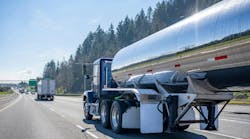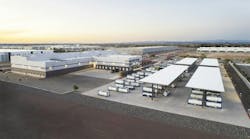DESPITE taking a hard hit during the Great Recession, the US trucking industry seems to be in the midst of a solid recovery. Shipments are increasing, and carriers reported tighter capacity for much of the first half of 2010.
“While there are still some threats ahead, the economic environment continues to improve for trucking,” Costello said. “The current growth cycle is sustainable, and trucking is making good gains. For instance, tank truck loads were growing at a 6.5% rate through March, and tank truck revenue per mile increased by 2.8% during that same time.”
“At this point, our biggest concern is the federal debt poses a serious long-term threat for the entire US economy. The percentage of debt to gross domestic product will approach 100% by 2020. We haven't seen anything like this since a brief period during World War II.”
Great Recession
The turnaround in fortunes for tank truck fleets and other trucking companies comes after one of the worst economic downturns in US history. For much of trucking, the recession actually started in 2007 followed by a steep plunge in late 2008 that didn't slow until the second half of 2009.
As the Wall Street banking and financial sector melted down in late 2008, businesses of all sizes across the United States collapsed or teetered on the brink of failure. More than 8.4 million jobs were lost during the recession, and US payrolls fell by 5.5%.
The abrupt slowdown in the economy brought a historic drop in transportation capacity as freight volumes plunged. From late 2008 through most of 2009, truckload shipments fell 12.1% on average. For smaller fleets, the freight volume decline was in excess of 17%.
“On the tank truck side, loads fell by 16.3% during 2009, and the load decrease peak-to-trough topped 28%,” Costello said. “Revenues per mile for the tank truck industry fell 16.7% peak-to-trough.”
Plummeting shipment volumes prompted approximately 2,000 fleets (with five trucks or more) to cease operations in 2009, and nearly 800 more exited the business in the first quarter to 2010. Surviving carriers cut capacity ruthlessly.
“The overall tank truck fleet in the United States is 14% smaller than it was a year ago,” Costello said. “Fleets are still cautious, and many are still not buying much new equipment even though utilization is improving and the driver shortage has returned. We expect more fleet shutdowns despite the economic improvement.”
Economic improvement
Clearly, there has been economic improvement, and the tank truck fleets that made it though the recession are benefitting. Manufacturing output rose more than 5% during the first part of 2010 and should continue at about the same pace through 2011. Retail sales also are showing good improvement.
Automobile production is forecast to grow from about 11.8 million units this year to 15.6 million vehicles by 2012. “This sector is in recovery, and that is good for the tank truck industry that hauls many liquid and dry bulk cargoes used in the manufacture of automobiles,” Costello said.
Plastics production is expected to grow by more than 5% annually in 2010 and 2011. Chemical production has rebounded robustly after bottoming out in 2009. “We are projecting 6.4% growth in chemical production in 2010, followed by 3.6% and 3.1% growth respectively in 2011 and 2012,” Costello said.
Cement production will take longer to recover because commercial construction is lagging behind the overall recovery. “Big projects simply take longer to plan and execute,” Costello said.
Ample loads
These growth factors suggest ample loads for a tank truck industry that has gone through a significant downsizing. “Once supply and demand reach a point of near equilibrium, we're likely to witness the tightest capacity environment the industry has ever faced,” Costello said. “We're not going to have enough drivers or trucks.”
The truckload side is already dealing with tighter fleet capacity, as evidenced by spot market pricing, Costello said during the May meeting. Tank fleets are reporting a similar situation, with only the less-than-truckload sector still reporting over capacity.
Factors contributing to tighter capacity include driver layoffs and a significant reduction in fleet power units. Fleets exported a significant number of used Class 8 tractors over the past few years, and many carriers have indicated that they will not buy significant numbers of new trucks until at least 2011.
“Class 8 truck sales are well below any reasonable replacement schedule,” Costello said. “We continue to dispose of more trucks that we are bringing online. In fact, 2009 was one of the best years for used equipment exports from the United States.”
Actions by the federal government will exacerbate the capacity situation. Increased federal regulatory activity has raised or will raise new barriers to entry for trucking. Many of these regulations — the latest engine requirements from the Environmental Protection Agency, new truck driver hours of service, electronic on-board recorders, and CSA 2010 — bring new costs for compliance.
Fuel prices — and possibly availability — will remain volatile. Fleets will have to maintain tight control over operations to run as efficiently as possible. Probability is high that the price of oil will reach, and even exceed, $100 a barrel in coming years.
Despite those challenges, Costello predicted a good future for the tank truck fleets with proactive management teams. Those fleets certainly should have plenty of business over the next couple of years.












